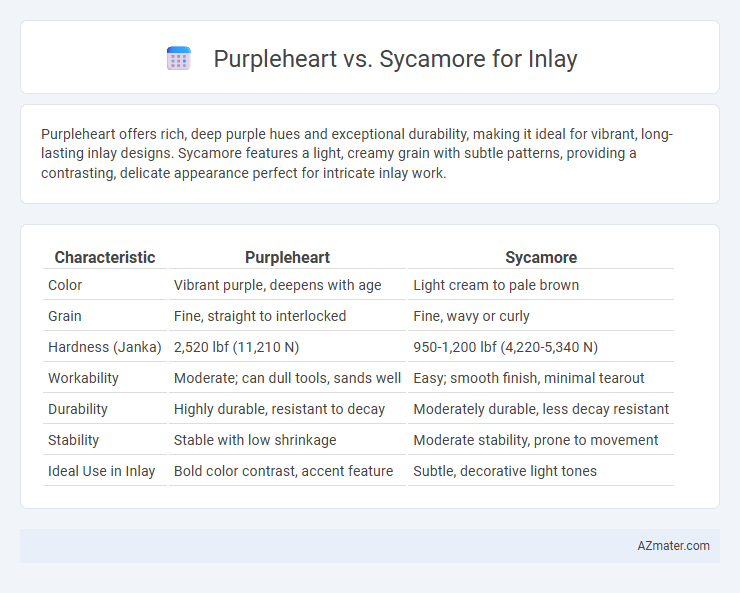Purpleheart offers rich, deep purple hues and exceptional durability, making it ideal for vibrant, long-lasting inlay designs. Sycamore features a light, creamy grain with subtle patterns, providing a contrasting, delicate appearance perfect for intricate inlay work.
Table of Comparison
| Characteristic | Purpleheart | Sycamore |
|---|---|---|
| Color | Vibrant purple, deepens with age | Light cream to pale brown |
| Grain | Fine, straight to interlocked | Fine, wavy or curly |
| Hardness (Janka) | 2,520 lbf (11,210 N) | 950-1,200 lbf (4,220-5,340 N) |
| Workability | Moderate; can dull tools, sands well | Easy; smooth finish, minimal tearout |
| Durability | Highly durable, resistant to decay | Moderately durable, less decay resistant |
| Stability | Stable with low shrinkage | Moderate stability, prone to movement |
| Ideal Use in Inlay | Bold color contrast, accent feature | Subtle, decorative light tones |
Introduction to Purpleheart and Sycamore
Purpleheart, known for its rich, vibrant purple hue and exceptional hardness, is a popular choice for wood inlays that demand durability and striking color contrast. Sycamore features a lighter, creamy beige tone with subtle grain patterns, offering a softer, more understated aesthetic that complements a wide range of designs. Both woods are favored for their workability and smooth finish, making them ideal for intricate inlay projects requiring precision and visual appeal.
Key Characteristics of Purpleheart Wood
Purpleheart wood is prized for its vibrant purple hue that deepens over time, providing a striking visual contrast in inlay work. Its high density and hardness, with Janka hardness around 2,520 lbf, offer excellent durability and resistance to wear, making it ideal for intricate, lasting designs. The wood's fine, straight grain and smooth texture enable clean cuts and detailed inlay patterns unmatched by the lighter, more porous sycamore.
Unique Properties of Sycamore Wood
Sycamore wood features a fine, even texture with a light, creamy color that contrasts beautifully against darker woods like Purpleheart, making it ideal for intricate inlays. Its natural strength and stability reduce warping or cracking over time, ensuring long-lasting durability in decorative applications. The subtle grain patterns of Sycamore provide a delicate, almost translucent appearance, enhancing the visual complexity without overpowering the bold hues of Purpleheart.
Visual Appeal: Color and Grain Comparison
Purpleheart wood exhibits a striking deep purple hue that intensifies over time, offering a bold and unique visual appeal for inlays. Sycamore features a lighter, creamy color with subtle, wavy grain patterns that provide a softer, more delicate contrast. The choice between Purpleheart and Sycamore hinges on whether a rich, vibrant color or a gentle, understated texture best suits the desired aesthetic of the inlay project.
Workability: Cutting, Shaping, and Finishing
Purpleheart wood exhibits excellent workability for inlay projects, offering smooth cutting and shaping with minimal splintering due to its dense, fine grain. Sycamore, while generally workable, can present challenges such as uneven grain that may cause tear-out during cutting but sands to a smooth finish once carefully handled. Both woods accept finishes well, but Purpleheart's hardness lends durability to the inlay, whereas Sycamore offers a lighter color contrast important for detailed designs.
Durability and Longevity in Inlays
Purpleheart, prized for its deep purple hue and dense grain, offers exceptional durability and resistance to wear, making it ideal for long-lasting inlays that maintain their integrity over time. Sycamore, while visually appealing with its pale and consistent texture, is softer and more prone to dents and scratches, affecting the longevity of inlays in high-traffic applications. For projects demanding robust, resilient inlays, Purpleheart outperforms Sycamore in terms of durability and sustained aesthetic appeal.
Compatibility with Other Woods
Purpleheart's deep purple hue contrasts sharply with lighter woods, making it ideal for inlays that require bold color differentiation and high visual impact. Sycamore offers a creamy, pale tone with unique figure patterns, blending seamlessly with most hardwoods for subtle, elegant inlay work. Both woods exhibit stable hardness and machinability, ensuring reliable compatibility when joined with species like walnut, oak, or maple in intricate woodworking projects.
Cost and Availability Factors
Purpleheart is priced higher due to its exotic status and limited sources, making it less accessible for large-scale projects, whereas Sycamore is more affordable and widely available, often sourced from North American forests. The dense, vibrant purple hues of Purpleheart can justify the premium for unique, high-end inlay work, while Sycamore's pale, consistent grain offers budget-friendly versatility. Availability for Purpleheart fluctuates with seasonal imports and environmental restrictions, contrasting Sycamore's stable supply, which supports consistent project timelines and cost management.
Best Applications for Each Wood in Inlay
Purpleheart excels in inlay projects requiring vibrant color contrast and exceptional durability, making it ideal for decorative accents in high-traffic furniture or musical instruments. Sycamore's fine, even grain and pale tone lend themselves well to intricate, delicate inlays where subtle coloration and smooth carving are essential. Both woods offer unique aesthetic qualities: Purpleheart provides rich purples that darken over time, while Sycamore delivers a classic, natural look with excellent workability for detailed designs.
Choosing the Right Wood: Purpleheart vs Sycamore
Purpleheart offers vibrant purple hues and exceptional durability, making it ideal for eye-catching inlays requiring long-lasting color retention. Sycamore, known for its pale, creamy tones and subtle grain patterns, provides a softer contrast, enhancing intricate designs with a natural elegance. Choosing between Purpleheart and Sycamore depends on the desired visual impact and durability, with Purpleheart favoring bold, vibrant accents and Sycamore suited for understated, refined craftsmanship.

Infographic: Purpleheart vs Sycamore for Inlay
 azmater.com
azmater.com